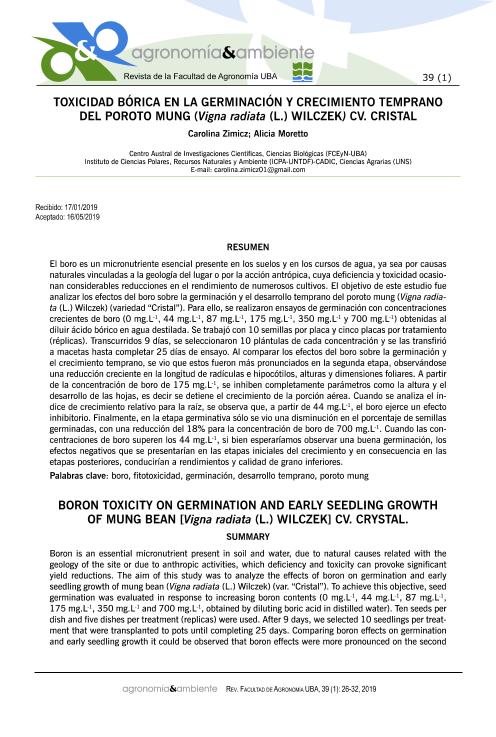Artículo
El boro es un micronutriente esencial presente en los suelos y en los cursos de agua, ya sea por causasnaturales vinculadas a la geología del lugar o por la acción antrópica, cuya deficiencia y toxicidad ocasionan considerables reducciones en el rendimiento de numerosos cultivos. El objetivo de este estudio fueanalizar los efectos del boro sobre la germinación y el desarrollo temprano del poroto mung (Vigna radiata (L.) Wilczek) (variedad ?Cristal?). Para ello, se realizaron ensayos de germinación con concentracionescrecientes de boro (0 mg.L-1, 44 mg.L-1, 87 mg.L-1, 175 mg.L-1, 350 mg.L-1 y 700 mg.L-1) obtenidas aldiluir ácido bórico en agua destilada. Se trabajó con 10 semillas por placa y cinco placas por tratamiento(réplicas). Transcurridos 9 días, se seleccionaron 10 plántulas de cada concentración y se las transfirióa macetas hasta completar 25 días de ensayo. Al comparar los efectos del boro sobre la germinación yel crecimiento temprano, se vio que estos fueron más pronunciados en la segunda etapa, observándoseuna reducción creciente en la longitud de radículas e hipocótilos, alturas y dimensiones foliares. A partirde la concentración de boro de 175 mg.L-1, se inhiben completamente parámetros como la altura y el desarrollo de las hojas, es decir se detiene el crecimiento de la porción aérea. Cuando se analiza el índice de crecimiento relativo para la raíz, se observa que, a partir de 44 mg.L-1, el boro ejerce un efectoinhibitorio. Finalmente, en la etapa germinativa sólo se vio una disminución en el porcentaje de semillas germinadas, con una reducción del 18% para la concentración de boro de 700 mg.L-1. Cuando las concentraciones de boro superen los 44 mg.L-1, si bien esperaríamos observar una buena germinación, losefectos negativos que se presentarían en las etapas iniciales del crecimiento y en consecuencia en lasetapas posteriores, conducirían a rendimientos y calidad de grano inferiores. Boron is an essential micronutrient present in soil and water, due to natural causes related with the geology of the site or due to anthropic activities, which deficiency and toxicity can provoke significant yield reductions. The aim of this study was to analyze the effects of boron on germination and early seedling growth of mung bean (Vigna radiata (L.) Wilczek) (var. “Cristal”). To achieve this objective, seed germination was evaluated in response to increasing boron contents (0 mg.L-1, 44 mg.L-1, 87 mg.L-1, 175 mg.L-1, 350 mg.L-1 and 700 mg.L-1, obtained by diluting boric acid in distilled water). Ten seeds per dish and five dishes per treatment (replicas) were used. After 9 days, we selected 10 seedlings per treatment that were transplanted to pots until completing 25 days. Comparing boron effects on germination and early seedling growth it could be observed that boron effects were more pronounced on the second stage, with a constant and increasing reduction on radicle and shoot lengths, heights and plant foliar dimensions. Height and leaves growth were completely inhibited at boron concentrations higher than 175 mg.L-1, resulting in aerial biomass growth suppression, and relative growth indexes were inhibited at boron concentrations higher than 44 mg.L-1. Finally, regarding germination, we only observed a decrease in germination percentages, with reduction of 18% with boron concentrations higher than700 mg.L-1. When boron concentrations exceed 44 mg.L-1, although we would expect to observe good germination, the negative effects that would occur in the initial stages of growth and consequently in later ones, would lead to lower grain yields and quality.
Toxicidad bórica en la germinación y crecimiento temprano del poroto mung (vigna radiata (l.) wilczek) cv. cristal
Fecha de publicación:
05/2019
Editorial:
Universidad de Buenos Aires. Facultad de Agronomía
Revista:
Agronomía&Ambiente
ISSN:
2314 2243
e-ISSN:
2344-9039
Idioma:
Español
Tipo de recurso:
Artículo publicado
Clasificación temática:
Resumen
Palabras clave:
boro
,
desarrollo temprano
,
poroto mung
,
fitotoxicidad
Archivos asociados
Licencia
Identificadores
Colecciones
Articulos(CADIC)
Articulos de CENTRO AUSTRAL DE INVESTIGACIONES CIENTIFICAS
Articulos de CENTRO AUSTRAL DE INVESTIGACIONES CIENTIFICAS
Citación
Zimics, Carolina; Moretto, Alicia Susana; Toxicidad bórica en la germinación y crecimiento temprano del poroto mung (vigna radiata (l.) wilczek) cv. cristal; Universidad de Buenos Aires. Facultad de Agronomía; Agronomía&Ambiente; 39; 1; 5-2019; 1-7
Compartir




